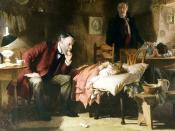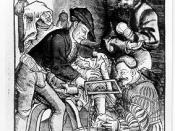During the Civil War, many of the techniques in medicine that we now take for granted had not yet be invented and the proper treatment for many communicable diseases was limited. The deaths in the hospitals were as numerous as the deaths on the battlefield. These facts made being wounded in battle or even just getting sick something to really worry about. Even very minor wounds were often fatal.
The prevailing idea of what was wrong with a soldier when he got sick was that his fluids were out of balance. So, the doctor would cut into the affected area and allowed it to bleed, draining of a pint or two of blood. Leeches were also used to drain blood. Many, as a result, died from an intentional loss of blood.
Amputation was the most common among all the procedures. In fact, 71% of all bullet wounds resulted in the amputation of a limb.
Also, all of these amputations were usually done using little to no anesthetics. Just imagine some doctor, most likely just out of school, sawing away at your arm or leg with nothing to so much as dull the pain.
Now don't get the impression that most of the wounds came from the battlefield. Disease and infection sent men to the hospital twice as often as wounds from the battlefield. Adding to this dilemma, doctors knew nothing about the connection between germs and infection.
Surgery, such a common word today, was the cause of much fear for soldiers. Before a surgical procedure, the doctor would examine the wound and decide what medical procedure was necessary. Then the doctor would remove the knives from his mouth and would hastily wipe them off on his blood-stained apron. Then he would begin the operation.
Medicine during this time period...


